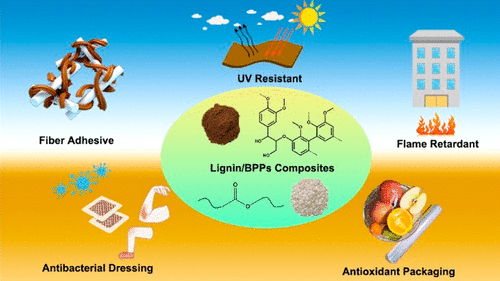当前位置:
X-MOL 学术
›
ACS Sustain. Chem. Eng.
›
论文详情
Our official English website, www.x-mol.net, welcomes your feedback! (Note: you will need to create a separate account there.)
Technical Lignin Valorization in Biodegradable Polyester-Based Plastics (BPPs)
ACS Sustainable Chemistry & Engineering ( IF 8.4 ) Pub Date : 2021-08-30 , DOI: 10.1021/acssuschemeng.1c03705 Si-Jie Zhou 1 , Han-Min Wang 1 , Shao-Jun Xiong 1 , Jing-Meng Sun 2 , Yun-Yan Wang 3 , Shixin Yu 1 , Zhuohua Sun 1 , Jia-Long Wen 1 , Tong-Qi Yuan 1
ACS Sustainable Chemistry & Engineering ( IF 8.4 ) Pub Date : 2021-08-30 , DOI: 10.1021/acssuschemeng.1c03705 Si-Jie Zhou 1 , Han-Min Wang 1 , Shao-Jun Xiong 1 , Jing-Meng Sun 2 , Yun-Yan Wang 3 , Shixin Yu 1 , Zhuohua Sun 1 , Jia-Long Wen 1 , Tong-Qi Yuan 1
Affiliation

|
Synthetic plastics have been reshaping the planet since the early 20th century. They have brought plenty of conveniences to our lives; meanwhile, plastic wastes discarded into the environment are resistant to biodegradation, accumulating in soil, water, and even in organisms. Biodegradable polyester-based plastics (BPPs), such as polylactic acid (PLA), poly(butylene adipate-co-terephthalate) (PBAT), poly(butylene succinate) (PBS), polycaprolactone (PCL), and poly(β-hydroxybutyric acid) (PHB) are considered to be ecofriendly and sustainable alternatives and have thrived rapidly in the past few decades. However, the applications of BPPs have been limited by their high prices compared to conventional plastics, while blending with low-cost fillers has been deemed to be a facile and efficient solution to the foregoing issues. Technical lignin, a class of biodegradable aromatic polymers, has been extracted/isolated at a large scale as a coproduct in the conventional paper-making and the emerging lignocellulosic biorefinery industries. The economically competitive BPP composites reinforced by coproduct lignin could not only facilitate the lignin valorization but also improve the economic viability of the lignocellulosic biorefinery. At present, the key obstacle lies in the incompatibility between lignin and BPPs resulting from self-aggregation and thermal condensation of lignin due to its polyhydroxy aromatic structures. Herein, we overviewed a series of effective approaches to promote the interaction between lignin and BPPs by adding plasticizers and blocking the hydroxyl groups. Furthermore, lignin can act as functional fillers endowing lignin/BPP composites favorable versatilities and expanding their applications in the fields of flame retardant packaging, food packaging, medical materials, outside packaging, and mulching films. In the end, we review the developments of lignin/BPP blending composites in the future and propose current problems that need to be solved.
中文翻译:

可生物降解聚酯基塑料 (BPP) 中的技术木质素增值
自 20 世纪初以来,合成塑料一直在重塑地球。他们给我们的生活带来了很多便利;同时,丢弃到环境中的塑料废物具有抗生物降解性,会在土壤、水甚至生物体中积累。可生物降解的聚酯类塑料(BPPS),如聚乳酸(PLA),聚(丁烯己二酸酯共-对苯二甲酸酯)(PBAT)、聚(丁二酸丁二醇酯)(PBS)、聚己内酯(PCL)和聚(β-羟基丁酸)(PHB)被认为是环保和可持续的替代品,并在过去几十年中迅速发展。然而,与传统塑料相比,BPP 的应用受到其高价格的限制,而与低成本填料混合被认为是上述问题的简便有效的解决方案。工业木质素是一类可生物降解的芳香族聚合物,作为传统造纸和新兴木质纤维素生物精炼行业的副产品,已被大规模提取/分离。由副产物木质素增强的具有经济竞争力的 BPP 复合材料不仅可以促进木质素的增值,而且还可以提高木质纤维素生物精炼厂的经济可行性。目前,主要障碍在于木质素由于其多羟基芳族结构而自聚集和热缩合导致木质素与BPPs之间的不相容性。在此,我们概述了一系列通过添加增塑剂和阻断羟基来促进木质素与 BPP 相互作用的有效方法。此外,木质素可以作为功能性填料,赋予木质素/BPP复合材料良好的多功能性,并扩大其在阻燃包装、食品包装、医疗材料、外包装和地膜等领域的应用。到底,
更新日期:2021-09-13
中文翻译:

可生物降解聚酯基塑料 (BPP) 中的技术木质素增值
自 20 世纪初以来,合成塑料一直在重塑地球。他们给我们的生活带来了很多便利;同时,丢弃到环境中的塑料废物具有抗生物降解性,会在土壤、水甚至生物体中积累。可生物降解的聚酯类塑料(BPPS),如聚乳酸(PLA),聚(丁烯己二酸酯共-对苯二甲酸酯)(PBAT)、聚(丁二酸丁二醇酯)(PBS)、聚己内酯(PCL)和聚(β-羟基丁酸)(PHB)被认为是环保和可持续的替代品,并在过去几十年中迅速发展。然而,与传统塑料相比,BPP 的应用受到其高价格的限制,而与低成本填料混合被认为是上述问题的简便有效的解决方案。工业木质素是一类可生物降解的芳香族聚合物,作为传统造纸和新兴木质纤维素生物精炼行业的副产品,已被大规模提取/分离。由副产物木质素增强的具有经济竞争力的 BPP 复合材料不仅可以促进木质素的增值,而且还可以提高木质纤维素生物精炼厂的经济可行性。目前,主要障碍在于木质素由于其多羟基芳族结构而自聚集和热缩合导致木质素与BPPs之间的不相容性。在此,我们概述了一系列通过添加增塑剂和阻断羟基来促进木质素与 BPP 相互作用的有效方法。此外,木质素可以作为功能性填料,赋予木质素/BPP复合材料良好的多功能性,并扩大其在阻燃包装、食品包装、医疗材料、外包装和地膜等领域的应用。到底,



























 京公网安备 11010802027423号
京公网安备 11010802027423号